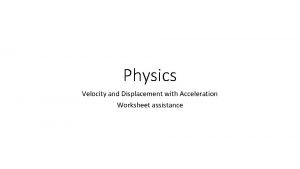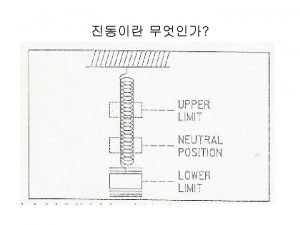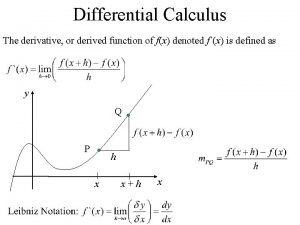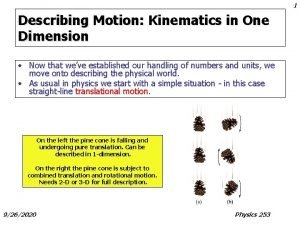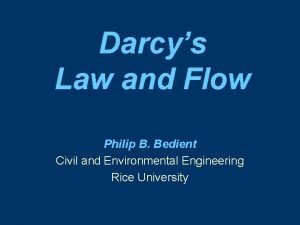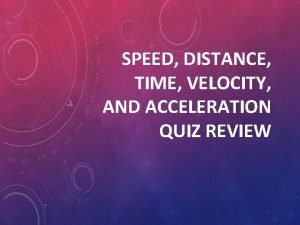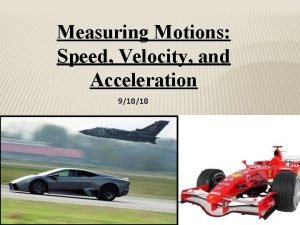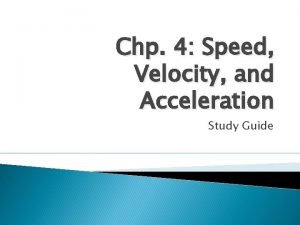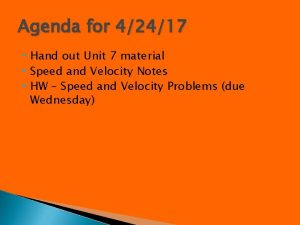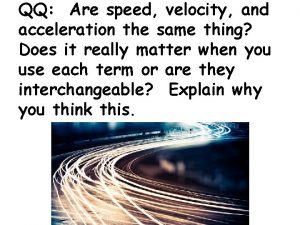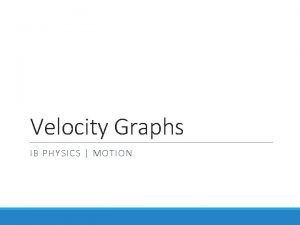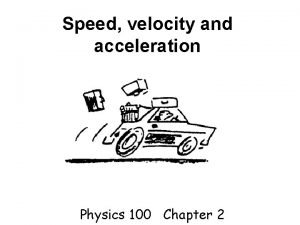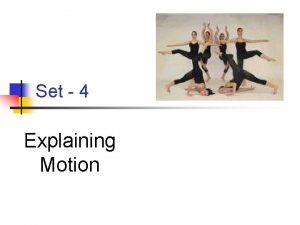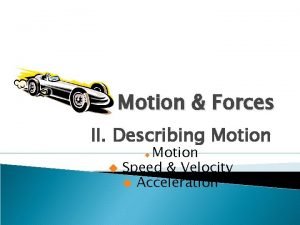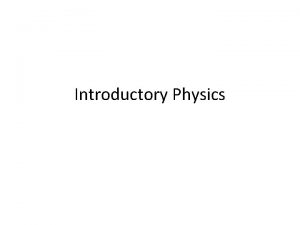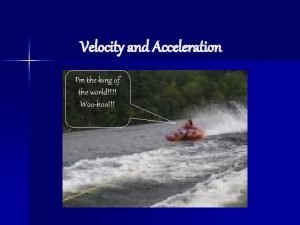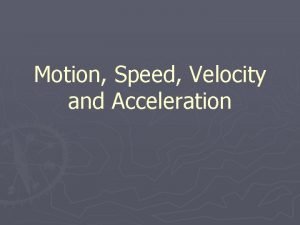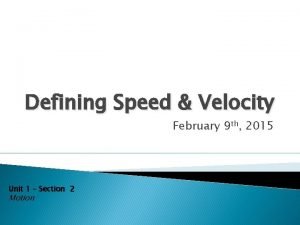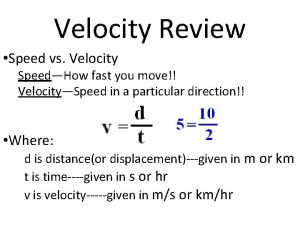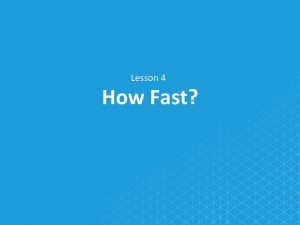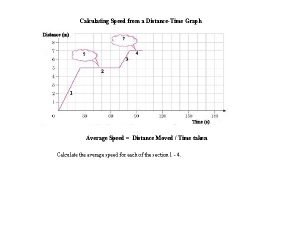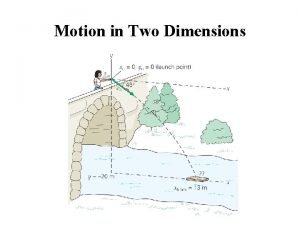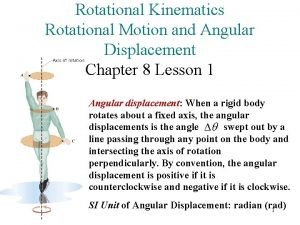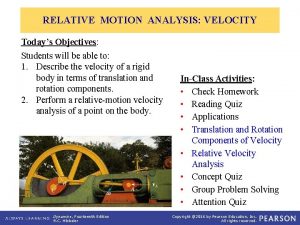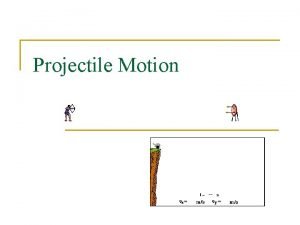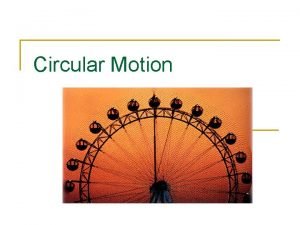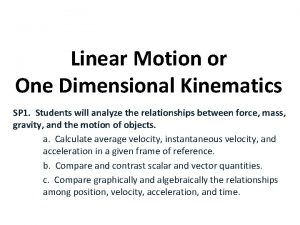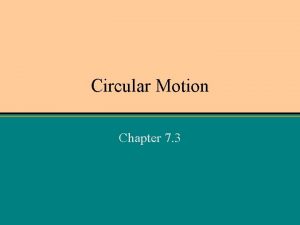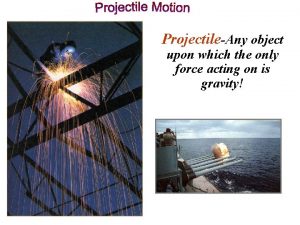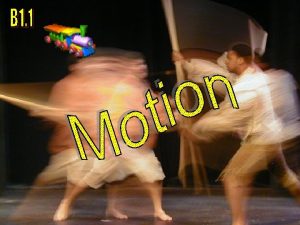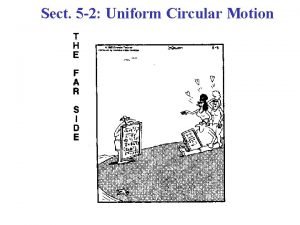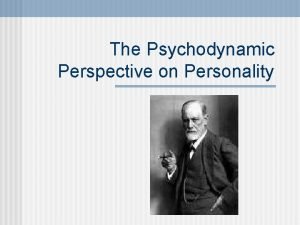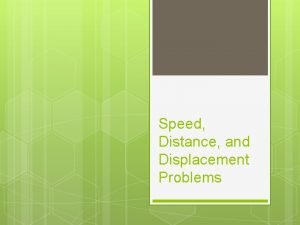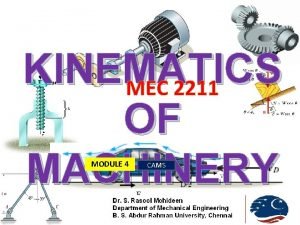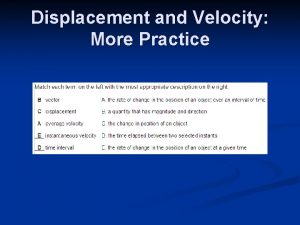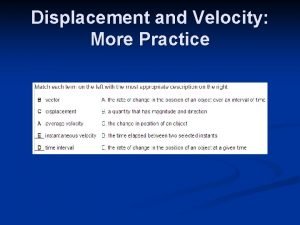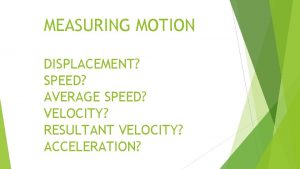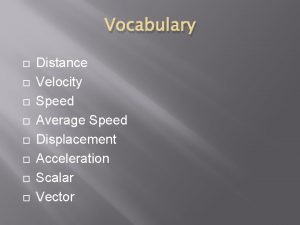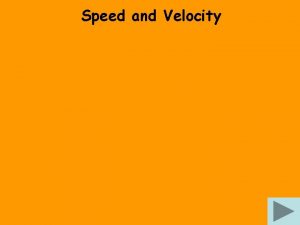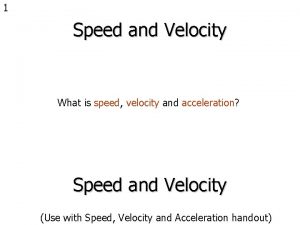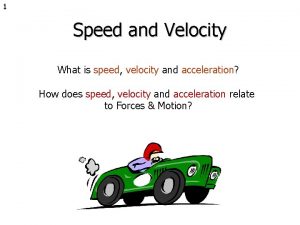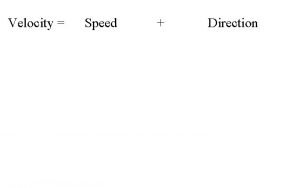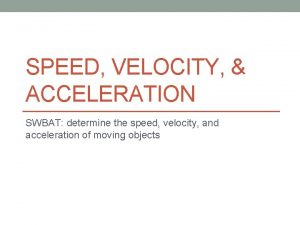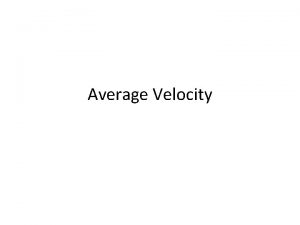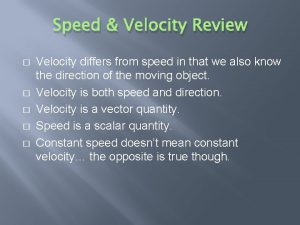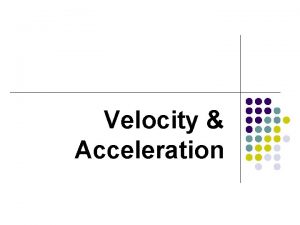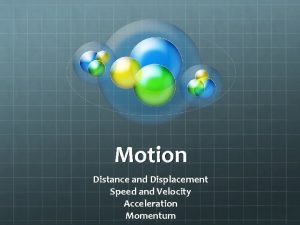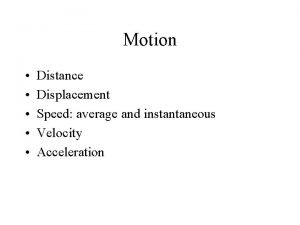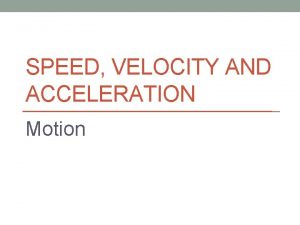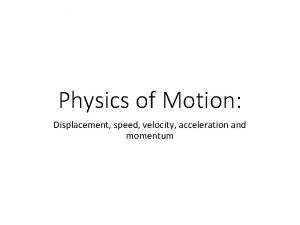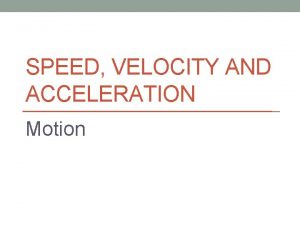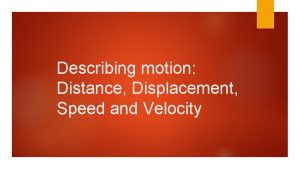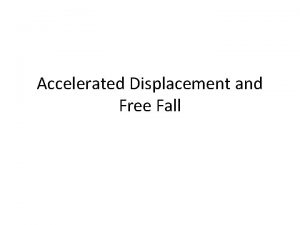Motion and Speed Displacement and Velocity Motion and




























































- Slides: 60

Motion and Speed

Displacement and Velocity

Motion and Position • Motion occurs when an object changes its position. • In order to tell if something has moved, you need a reference point. • An object is in motion if it changes position relative to a reference point.

Frame of Reference - In order to measure the distance of an object we must use a frame of reference. Point A ----> Point B - These are usually distinct points on the Earth's surface or distinguishing points in the sky.

Distance • How far something moves is distance. • Distance is measured in centimeters, meters or kilometers. • One km is equal to. 6 miles or 1000 meters.

Distance is a scalar quantity and tells you only the magnitude (number sum only) of a path taken.

Displacement • Displacement is the distance AND direction of an object’s change in position from starting point.

Displacement is the shortest distance between the starting point and the end point.

Distance vs. Displacement • You drive the path, and your odometer goes up by 8 miles (your distance). • Your displacement is the shorter directed distance from start to stop (yellow arrow). start stop


Constant speed A moving object that doesn’t change it’s speed travels at constant speed n Constant speed means equal distances are covered in an equal amount of time n

Calculating Speed • Speed = Distance Time • Distance = speed x time • Time = Distance Speed If a runner travels 100 m in 10 seconds what was his average speed?

Calculating Speed • Speed is distance divided by time. • Distance is meters and time is seconds. • Other units can be used, such as kph or mph.

SPEED Speed is the distance that an object travels in a period of time. Units are meters and seconds (and therefore meters per second). However, sometimes km/hr is more sensible. d t v A cyclist travels 25 km in ½ an hour. What is their speed - in kph = 25 km/0. 5 hr = 50 km/hr - in mps = 25000 m/1800 s = 14 m/s


• instantaneous velocity - the velocity that something has at any one instance – (The terms instantaneous speed and avg. speed may also be used)

The average velocity for a trip might be 53 miles/hour. However, during this trip your instantaneous speed might have been 0 miles/hour at a stoplight or 70 miles/hour on the open road.

Really…you think YOU are FAST?

Speed Records Vehicles • Conventional passenger train… 456 mph • Hydroplane… 317 mph • Land car… 763 mph • NASCAR … 213 mph…Bill Elliot!

Birds • Peregrine falcon… 217 mph (dive) • Hummingbird… 62 mph • Ostrich … 40 mph

Fish • Fastest man… 5 mph • Great white burst… 15 mph • Mako Shark…burst 60 mph…you’re dinner. • Killer whale… 25 mph … that’s why they call them killer! • Dolphin… 35 mph • Sailfish… 68 mph

Other sea creatures • Shrimp… 1. 9 mph • Sea turtle… 22 mph • Crab… 4. 7 mph • Octopus 25 mph…sad but faster than you!

Mammals • Cheetah… 70 mph • Pronghorn Antelope… 65 mph • Lion… 50 mph • Tiger… 50 mph

Mammals cont. • Grey wolf… 45 mph… • Racehorse… 40 • Grizzly bear… 30 mph • Wart hog… 30 mph

Getting’ slower! • Dog … 40 mph • Cat … 30 mph • Elephant… 25 mph • Man… 23 mph • Mouse… 8 mph

You still better run! • Black mambo snake… 20 mph • Bee… 11 mph • Cockroach… 3. 4 mph • Spider… 1. 17 mph • Snail… 0. 03 mph…

Motion with Constant Speed • Motion or speed can change or stay constant. • With constant speed, speed does not change.

Speed • Speed can – Change – Be average – Be instantaneous

Average vs Instantaneous • Average speed is the total distance traveled divided by the total time of travel. • S = d/t • Instantaneous speed is the speed at a given point in time. • Use a speedometer. • If something is speeding up or slowing down instantaneous speed is changing.

Calculations • Sound travels at a speed of 330 m/s. If a lightning bolt strikes the ground 1 km away from you, how long will it take the sound of thunder to get to you?

• S = d/t so t = d/s • t = 1 km/330 m/s = 1000 m/330 m/s = 3. 03 s

Graphing Motion • A distance-time graph displays motion of an object over time. So, what is going on?

Plotting a distance–time graph • Distance is on the vertical axis • Time is on the horizontal axis • Appropriate time and distance intervals are added • Data is plotted • Line is drawn

DISTANCE/TIME GRAPHS A car takes 1. 5 minutes to travel 500 m down a busy road. It stops at lights for 30 seconds, then continues on for 1 minute as it goes another 1 km. Plot this on a distance/time graph. Using the distance/time graph: 1. 5 Distance (km) 1 1. What is the total distance 0. 5 traveled? = 1. 5 2. In what part of the tripkm = part is the car going the fastest? 3 3. What is the fastest v = Δd / Δt speed? Δd = 1 km Steepest section is fastest Δt = 1 min 1 2 Time (min) 3 In a distance/time graph the slope of the line = v = 1000 m/60 s the speed of the object. v = 16. 66 m/s v = 1 km/1 min

Can you tell what this vehicle is doing? • The car went 10 m/s for 150 seconds (A), then the car accelerated until it got to (B) when it was finally going 30 m/s. The car then went 30 m/s for 50 seconds (C). Finally, the car decelerated from 30 m/s to 5 m/s for the final 50 seconds of its journey (D).

SPEED QUESTIONS What would these look like on a distance/time graph? 1. stopped 2. slow 3. fast 4. accelerating

SPEED/TIME GRAPHS A runner travels at 4 m/s for 10 seconds, then stops suddenly for 5 seconds, then accelerates for 5 seconds to get to 8 m/s and continues for 10 seconds. Plot this on a speed/time graph. Speed (m/s) Using the speed/time graph: In what part of the trip is the runner going the fastest? = part 5 8 4 10 20 Time (sec) In a speed/time graph the slope of the line = the acceleration of the object. 30

Velocity Part 2

Velocity • Velocity is the speed and direction of movement. – Speed in a given direction is velocity. – For example, a storm is moving east at 25 miles per hour, is the velocity of the storm.

Velocity • Because velocity depends on speed and direction, the velocity of an object can change even if the speed, direction or both change. • Think NASCAR.

Resultant Velocity Resultant velocity is when you combine two velocities.

Resultant Velocity When you combine two velocities that are in the same direction, you add them together to get the resultant velocity. When you combine two velocities that are in opposite directions, subtract the smaller velocity from the larger velocity. The resultant velocity is in the direction of the larger velocity.

If the plane is traveling at a velocity of 100 km/hr with respect to the air, and if the tailwind velocity is 25 km/hr, then what is the velocity of the plane relative to an observer on the ground below? Science Rules!


Understand? ? ?

Now… • Suppose a plane traveling with a velocity of 100 km/hr with respect to the air meets a headwind with a velocity of 25 km/hr. In this case, the resultant velocity would be 75 km/hr.

Get it?

Acceleration • Acceleration is the rate of change in velocity. • When velocity changes, acceleration changes.


Acceleration cont… • Remember, velocity is involves speed and direction. • Sooooo, if speed or direction change, or both actually, acceleration occurs. • Acceleration is not just speeding up.

Acceleration When a motorcycle changes direction, its velocity changes too.

Positive acceleration • Positive acceleration is an increase in speed.

Negative acceleration • Slowing down is negative acceleration.

Changing direction • Changing direction is also acceleration because the moving object is changing velocity.

Calculating Acceleration change in velocity • Acceleration = time • Subtract the initial velocity from the final velocity to get change in velocity. • Vi stands for initial velocity and vf stands for final velocity.

units • Acceleration is a unit of velocity divided by a unit of time. • The SI unit for velocity is meters per second (m/s) and the SI for time is seconds (s). • So, the unit for acceleration is meters /second which is written as m/s 2 and is read as meters per second squared.

ACCELERATION Acceleration is the change in velocity in an object in a period of time. Δv Units ms/s or ms 2 a Δt It takes a cyclist 20 seconds to go from a standing start to 14 m/s. What is the acceleration? What is 14 m/s in km/hr? a = Δv/Δt a = 14 m/s / 20 s a = 0. 7 ms 2 = 14 × 60 s × 60 min 1000 m = 50. 4 km/hr

Calculating positive acceleration • A jet plane starts from rest at the end of the runway and reaches a speed of 80 m/s in 20 s. What is the jet’s acceleration? (vf – vi) ( 80 m/s – 0 m/s) • a= t = 20 s =4 m/s/s

Calculating negative acceleration • A skateboarder moving at 3 m/s comes to stop in 2 s. What is the acceleration? ( v f – v i) (0 m/s – 3 m/s) • a= t = 2 s = -1. 5 m/s 2 • Since acceleration is a negative number, it is negative acceleration and the object is slowing down.

 Single displacement vs double displacement
Single displacement vs double displacement Displacement velocity and acceleration worksheet
Displacement velocity and acceleration worksheet Vibration displacement velocity acceleration
Vibration displacement velocity acceleration Differential calculus functions
Differential calculus functions Linear to angular velocity
Linear to angular velocity Initial velocity and final velocity formula
Initial velocity and final velocity formula Speed unit
Speed unit Darcy kroeker
Darcy kroeker Is v final velocity
Is v final velocity Instantaneous velocity vs average velocity
Instantaneous velocity vs average velocity Darcy law example
Darcy law example Tangential speed
Tangential speed Minimum velocity
Minimum velocity Speed velocity and acceleration quiz
Speed velocity and acceleration quiz Speed, velocity and acceleration problems
Speed, velocity and acceleration problems Motion in a straight line
Motion in a straight line Speed and velocity venn diagram
Speed and velocity venn diagram Speed velocity acceleration
Speed velocity acceleration Velocity describes both speed and
Velocity describes both speed and Speed velocity and acceleration formulas
Speed velocity and acceleration formulas Speed velocity and acceleration study guide answers
Speed velocity and acceleration study guide answers Speed challenge lab
Speed challenge lab Are speed and acceleration the same thing
Are speed and acceleration the same thing Graph the particle's velocity and speed where defined
Graph the particle's velocity and speed where defined Chapter 2 motion section 1 describing motion answer key
Chapter 2 motion section 1 describing motion answer key Speed, velocity and acceleration notes
Speed, velocity and acceleration notes Chapter 1 lesson 2 speed and velocity answer key
Chapter 1 lesson 2 speed and velocity answer key Distinguish between speed and velocity class 9
Distinguish between speed and velocity class 9 Velocity and speed
Velocity and speed Difference between speed and velocity
Difference between speed and velocity Difference between speed and velocity
Difference between speed and velocity Motion describe
Motion describe Velocity describes both speed and
Velocity describes both speed and Speed and velocity
Speed and velocity Speed and velocity
Speed and velocity Comparing distance/time graphs to speed/time graphs
Comparing distance/time graphs to speed/time graphs Pmv triangle
Pmv triangle Constant velocity graph
Constant velocity graph What is acceleration
What is acceleration Light travels at 300 000 km/s
Light travels at 300 000 km/s Velocity v speed
Velocity v speed How to calculate average speed from a distance time graph
How to calculate average speed from a distance time graph Speed vs velocity
Speed vs velocity How to solve speed distance and time
How to solve speed distance and time A narrow field of vision (140 degrees or less) is called...
A narrow field of vision (140 degrees or less) is called... Speed detection of moving vehicle using speed cameras
Speed detection of moving vehicle using speed cameras Formula of horizontal velocity
Formula of horizontal velocity Si unit of angular velocity
Si unit of angular velocity Section 2 velocity and momentum
Section 2 velocity and momentum Relative motion analysis using rotating axes
Relative motion analysis using rotating axes Physics projectile motion formula
Physics projectile motion formula Maximum velocity in vertical circular motion
Maximum velocity in vertical circular motion Motion with constant velocity
Motion with constant velocity Instantaneous velocity circular motion
Instantaneous velocity circular motion An object upon which the only force is gravity.
An object upon which the only force is gravity. Indicates that you can draw an imaginary line
Indicates that you can draw an imaginary line Circular motion with constant speed
Circular motion with constant speed Types of motion
Types of motion Psychodynamic view of personality
Psychodynamic view of personality John drove south 120 km at 60 km/h
John drove south 120 km at 60 km/h Radial follower
Radial follower

